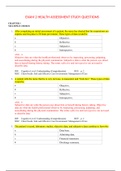Summary
Summary EXAM 2 HEALTH ASSESSMENT STUDY QUESTIONS
- Institution
- Chamberlain College Of Nursing
EXAM 2 HEALTH ASSESSMENT STUDY QUESTIONS CHAPTER 1 MULTIPLE CHOICE 1. After completing an initial assessment of a patient, the nurse has charted that his respirations are eupneic and his pulse is 58 beats per minute. These types of data would be: a. Objective. b. Reflective. c. Subjectiv...
[Show more]



